Evolution mechanism of wear characteristics of cylinder liner and piston ring under starved lubrication condition
IF 6.1
1区 工程技术
Q1 ENGINEERING, MECHANICAL
引用次数: 0
Abstract
This study investigates the sliding wear behavior of cylinder liners and piston rings under starved lubrication conditions, using a step-loading method to analyze the wear state transition of the cylinder liner. The wear scar surface and interface characteristics under different wear conditions were examined using optical microscopy (OM), white light interferometry, scanning electron microscopy (SEM), and transmission electron microscopy (TEM). The study also explores the mechanism behind the wear state transition. The results show that the friction coefficient initially increases, then decreases, and increases again with increasing load. The initial rise is attributed to an increase in surface roughness. As the tribo-layer forms, the friction coefficient gradually decreases. However, with a further increase in load, the tribo-layer begins to wear, leading to scuffing and a rapid increase in the friction coefficient. Graphite and phosphorus eutectic in the cylinder liner are the primary contributors to crack formation in both the tribo-layer and the substrate. Furthermore, the tribofilm formed on the initial wear scar surface also contributes to crack formation.
缺氧润滑条件下缸套和活塞环磨损特性演化机理
研究了无润滑条件下气缸套和活塞环的滑动磨损行为,采用阶梯加载法分析了气缸套的磨损状态转变。采用光学显微镜(OM)、白光干涉测量法、扫描电镜(SEM)和透射电镜(TEM)对不同磨损条件下的磨损疤痕表面和界面特征进行了研究。研究还探讨了磨损状态转变的机理。结果表明:随着载荷的增加,摩擦系数先增大后减小,再增大;最初的上升是由于表面粗糙度的增加。随着摩擦层的形成,摩擦系数逐渐减小。然而,随着载荷的进一步增加,摩擦层开始磨损,导致磨损,摩擦系数迅速增加。缸套中的石墨和磷共晶是摩擦层和衬底裂纹形成的主要原因。此外,在初始磨损疤痕表面形成的摩擦膜也有助于裂纹的形成。
本文章由计算机程序翻译,如有差异,请以英文原文为准。
求助全文
约1分钟内获得全文
求助全文
来源期刊

Tribology International
工程技术-工程:机械
CiteScore
10.10
自引率
16.10%
发文量
627
审稿时长
35 days
期刊介绍:
Tribology is the science of rubbing surfaces and contributes to every facet of our everyday life, from live cell friction to engine lubrication and seismology. As such tribology is truly multidisciplinary and this extraordinary breadth of scientific interest is reflected in the scope of Tribology International.
Tribology International seeks to publish original research papers of the highest scientific quality to provide an archival resource for scientists from all backgrounds. Written contributions are invited reporting experimental and modelling studies both in established areas of tribology and emerging fields. Scientific topics include the physics or chemistry of tribo-surfaces, bio-tribology, surface engineering and materials, contact mechanics, nano-tribology, lubricants and hydrodynamic lubrication.
 求助内容:
求助内容: 应助结果提醒方式:
应助结果提醒方式:


